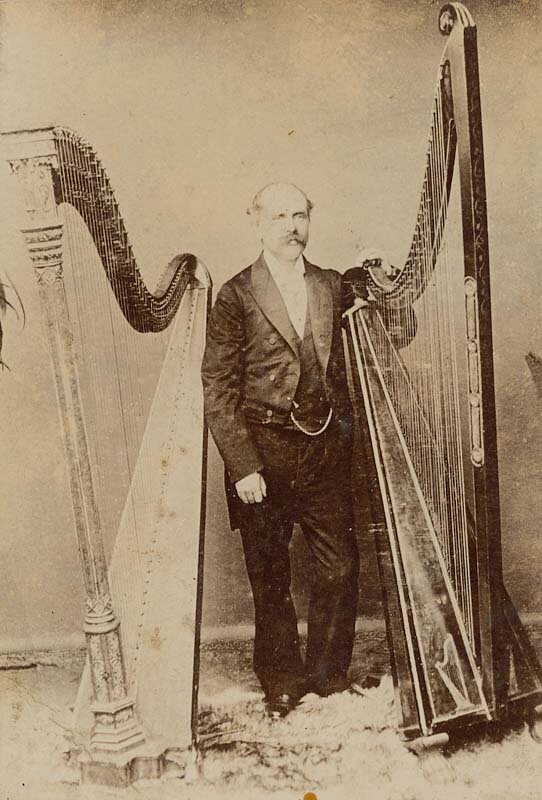
Montgomeryshire Yeomanry dress uniform
Montgomeryshire Yeomanry dress uniform. Birck red tunic with dark blue cuffs and collar with a welsh dragon badge pinned to the collar worn with a horsehair plumed helmet.

Trilobite Dingle
Near Welshpool by the Bron-y-Buckley woods can be found the famous Trilobite Dingle -a type of marine artiopodan arthropod.

Medieval encaustic floor-tile
One of several encaustic floor-tiles discovered at Strata Marcella Abbey.

Gold ‘posy’-ring from Sarn
Gold ‘posy’-ring from Sarn. Engraved with flowers and fleur-de-lis motifs on the outside and the words “In absence forget not” on the inner surface. The suggested date is 1580-1600.

Roman Coin Hoard
A Roman Coin hoard discovered near Montgomery in 2011 by a metal detectorist. 4854 roman coins dated between 238-274AD were excavated and are now on display in the Archaeology gallery.

Welsh Hand Loom & Flying Shuttles
From the 16th century Montgomeryshire was the centre of the Welsh textile industry. By the 1870s there were several smaller and 9 major woollen factories with over around 815 hand looms in operation in Llanidloes.

Scale-model of Van Mines lead mine at Y Fan
Scale-model of Van Mines lead mine at Y Fan

Miner’s Watch
Miner's watch holder, made from brass, used for carrying a watch underground in the mines. Used by a miner in Van Mines.

Miner’s Pith Helmet
Miner’s pith helmet from Van Mines, a lead mine operating between 1865 -1891 and was at one time the richest mine in the country

Town Seal (Llanidloes Coat of Arms)
Town Seal from early 1900s with Llanidloes’ coat of arms with the motto of St.Idloes ‘Goreu cynneddf cadw moes" ‘the best quality is that of maintaining morals’.

Police Constable's Truncheon
Police Constable's truncheon, said to have been taken from one of the London policemen during the Llanidloes riot in 1839. Since it bears the Arms of Welshpool Borough, it may have belonged to Constable Armishaw of Welshpool.

Penny Farthing
Penny Farthing circa 1880 ridden by a local Llanidloes woman.

Taxidermy Double Headed lamb
Taxidermy Double Headed lamb born on Maesnant Farm in 1914 and lived for 14 days

Castell Collen
A cremation urn from the Roman fort Castell Collen. Finds from this site were displayed in this building when it opened as a library in 1911. The building itself is also a treasure because it was built with funds from the philanthropist Andrew Carnegie, who set up free public libraries across the UK.

Ancient Log Boat
The discovery of an ancient log boat in the river Ithon in 1929 inspired the founding of the Llandrindod Wells Museum, which shared the library building. The boat has been dated by dendrochronology (tree rings) to about 1200 AD.

Fossil Trilobite
Around 460 million years ago, this part of Wales was a chain of volcanic islands. Weird-looking animals, like this extinct trilobite, lived in the sea. Now we find them as fossils in the rocks. Find out more at https://www.asoldasthehills.org or join the local Geology Group that meets at the museum.

Sheela-na-gig
The Llandrindod Wells sheela is in carved relief, with a crucifix incised on the right hand side (possibly inserted at a later date to the rest of the carving). Although found in a medieval context, it is likely to date from the Dark Ages or earlier.

Jon Cartoon
The cartoonist ‘Jon’ (William John Philpin Jones) was born in Llandrindod Wells in 1913. While suffering from shell-shock in North Africa, he created his famous cartoon characters, ‘The Two Types’, a pair of old-school officers first appearing in the ‘Eighth Army News’ in July 1944. Jones was awarded the MBE.

Knighton Whipping Post
This whipping post was sited by Knighton’s Old Town Hall which was demolished in 1872 to build the Clock Tower. The Whipping Act of 1530 authorized whipping of men and women for minor offences and insanity. During the 19th century, imprisonment replaced corporal punishment, but courts could order whippings for violent crimes.

Welsh Harp
The triple harp (or ‘Welsh harp’) is different from the more conventional harp as it has three sets of strings and no pedals. It originated in Italy around 1600, but became popular in Wales by the end of the 18th century. This one belonged to John Roberts (1816–1894).
